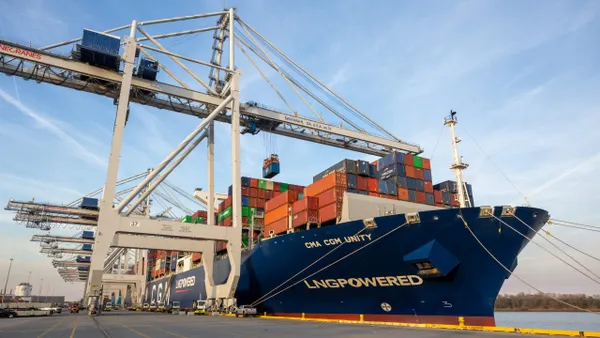Dive Brief:
- Almost 75% of U.S. businesses have experienced supply chain disruption as a result of the COVID-19 outbreak, according to a survey by the Institute for Supply Management (ISM) of 628 individuals conducted between February 22 and March 5. This comes after a survey by Thomas found 60% of North American manufacturers say operations have been affected by the COVID-19 outbreak, based on responses from 755 manufacturing company employees conducted in mid-February.
- ISM found 57% of respondents had experienced longer lead times for orders sourced from tier-1 suppliers in China. And 44% of respondents do not have a plan to address supply disruptions from China, of which the majority have experienced disruption, according to ISM.
- Thirty-one percent of respondents are dealing with the disruption by turning down or delaying orders, but another 28% said they were looking for alternative suppliers internationally and 28% said they were looking for new suppliers domestically, according to the Thomas survey.
Dive Insight:
The Institute for Supply Management published its purchasing managers index earlier this month and still showed signs of growth in the U.S. manufacturing sector, but respondents were already reporting production delays, longer lead times, lack of supplier visibility and difficulty sourcing parts as a result of the outbreak.
Events like the ongoing outbreak and other supply chain disruptions are the times when a lack of visibility can become a real problem for manufacturers, according to Sri Talluri, the Hoagland-Metzler endowed professor of supply chain management at Michigan State University.
"With higher levels of stock right now, we may not see the immediate effect," Talluri said in an interview with Supply Chain Dive, adding that a slowdown or pause in production could still come for some domestic manufacturers.
Many U.S.-manufacturers already have high levels of inventory at the beginning of the year as a result of the annual pause to production caused by the Chinese New Year. Factories in China are beginning to get back up and running again, but some U.S. companies likely don't have visibility past their first tier of suppliers in China, leaving open the question of their suppliers and their supplier's suppliers.
It will be important to keep an eye on smaller suppliers to know how the recovery is unfolding, Talluri said, but this might be easier said than done. More than half of respondents (53%) are having difficulty getting supply chain information from China, according to ISM.
If a company wants to get more visibility in its operation it might consider incentive mechanisms like profit-sharing contracts. This kind of long-term partnership can open up companies to information sharing and create a collaborative environment, Talluri said.
Companies cited shipping and logistics as the largest obstacle originating from the outbreak because the extended shutdown of Chinese factories resulted in decreased demand for ocean shipping and ocean carriers cut services. There are signs the situation is beginning to improve.
"The bulk of the blank sailings were announced during weeks 7 and 8," Sea-Intelligence Shipping Analyst Imaad Asad said in a release referring to the weeks of the year. "Weeks 9 and 10 have seen a clear tapering off in terms of new blank sailings, and the level of new announcements of blank sailings is back to the normal level. This means that carriers are seeing demand ramping up back to normal levels over the next few weeks as well."
While there are signs companies are struggling with visibility and shipping there is no indication the outbreak has resulted in U.S. factories shuttering, even temporarily.
"We've had no major customer shut down any type of operation or have any sort of impact at scale at any facility that I am aware of at this moment," Mac Pinkerton, president of C.H. Robinson’s North American Surface Transportation, told Supply Chain Dive in an interview.
But as the inventory stocks from the New Year begin to run low, the delays from ocean shipping might begin to show up in the form of shortages.
"The story the data tells is that companies are faced with a lengthy recovery to normal operations in the wake of the virus outbreak," ISM CEO Thomas W. Derry said in a statement. "For a majority of U.S. businesses, lead times have doubled, and that shortage is compounded by the shortage of air and ocean freight options to move product to the United States — even if they can get orders filled."














